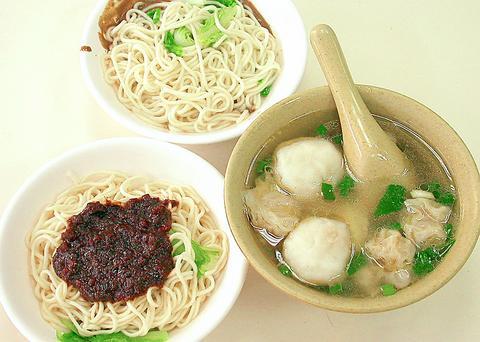Many of the first-time customers at Matsu Noodles Shop try to order "Matsu noodles," which they suppose is a type of noodles indigenous to the Matsu archipelago, one of Taiwan's outlying islands. There are in fact no Matsu-style noodles here and the name of the eatery was thought up ad hoc by its proprietress who happened to come from Matsu.
Located in a quieter section of Liaoning Street Night Market, the two-floor eatery is always crowded with all kinds of customers. Since opening over 10 years ago, the proprietress' family has pushed its business hours further and further into the night, finally opening 24 hours. Two years ago, it even expanded to include a neighboring two-floor space, which offers lunch boxes and rice dishes as well as noodles.
Matsu's noodles -- with pork sauce, sesame sauce, wonton, or sha-cha sauce -- do not sound much different from the menus of noodles stands everywhere, but their homemade recipes create a particular flavor that you won't find elsewhere. The sauces have a strong taste without being too greasy or heavy. The pork sauce mixes pork with pickled cucumbers. Both are so finely minced and mixed that the sauce has a rich flavor and blends well with the noodles. The sesame is finely ground in the sesame sauce. It is strongly fragrant and much less sweet than the usual kind. The sha-cha sauce is not greasy but highly appetizing. With a little bit of chili-pepper sauce, it taste even better.

PHOTO: VICO LEE, TAIPEI TIMES
Matsu's homemade wontons are relatively large and firm. A special way of wrapping the filling prevents the pork inside from losing its flavor when the wontons are served in soup. Noodles with oil is somewhat similar to the better-known Fuchou dry noodles, with its light taste and use of vegetable oil. This is a good choice if you want to taste the original flavor of Matsu's Fuchou-style noodles. All the noodles mentioned here come in large, medium and small sizes (NT$40, NT$35 and NT$25).
With mixed soup (NT$50), you can have a sampling of all the items Matsu is best at: two Fuchou fish balls with a filling of tasty pre-fried fish, some wontons and a smooth-tasting boiled egg. The eatery also has several homemade side dishes. Pork leg (NT$50), tender and light-tasting, is the most popular.

Seven hundred job applications. One interview. Marco Mascaro arrived in Taiwan last year with a PhD in engineering physics and years of experience at a European research center. He thought his Gold Card would guarantee him a foothold in Taiwan’s job market. “It’s marketed as if Taiwan really needs you,” the 33-year-old Italian says. “The reality is that companies here don’t really need us.” The Employment Gold Card was designed to fix Taiwan’s labor shortage by offering foreign professionals a combined resident visa and open work permit valid for three years. But for many, like Mascaro, the welcome mat ends at the door. A

Last week gave us the droll little comedy of People’s Republic of China’s (PRC) consul general in Osaka posting a threat on X in response to Japanese Prime Minister Sanae Takaichi saying to the Diet that a Chinese attack on Taiwan may be an “existential threat” to Japan. That would allow Japanese Self Defence Forces to respond militarily. The PRC representative then said that if a “filthy neck sticks itself in uninvited, we will cut it off without a moment’s hesitation. Are you prepared for that?” This was widely, and probably deliberately, construed as a threat to behead Takaichi, though it

Nov. 17 to Nov. 23 When Kanori Ino surveyed Taipei’s Indigenous settlements in 1896, he found a culture that was fading. Although there was still a “clear line of distinction” between the Ketagalan people and the neighboring Han settlers that had been arriving over the previous 200 years, the former had largely adopted the customs and language of the latter. “Fortunately, some elders still remember their past customs and language. But if we do not hurry and record them now, future researchers will have nothing left but to weep amid the ruins of Indigenous settlements,” he wrote in the Journal of

If China attacks, will Taiwanese be willing to fight? Analysts of certain types obsess over questions like this, especially military analysts and those with an ax to grind as to whether Taiwan is worth defending, or should be cut loose to appease Beijing. Fellow columnist Michael Turton in “Notes from Central Taiwan: Willing to fight for the homeland” (Nov. 6, page 12) provides a superb analysis of this topic, how it is used and manipulated to political ends and what the underlying data shows. The problem is that most analysis is centered around polling data, which as Turton observes, “many of these